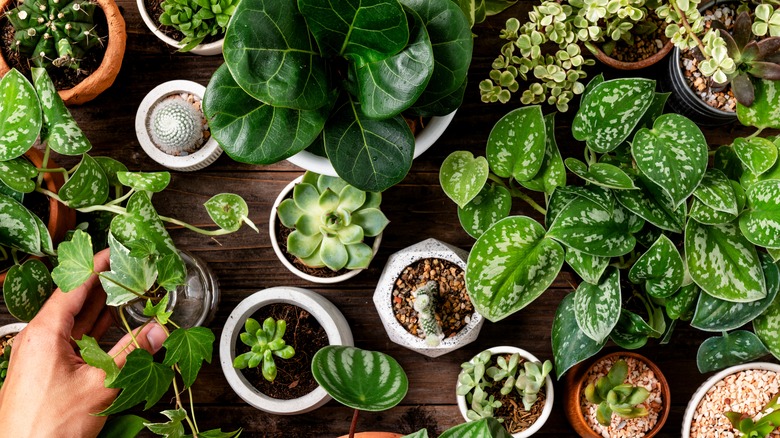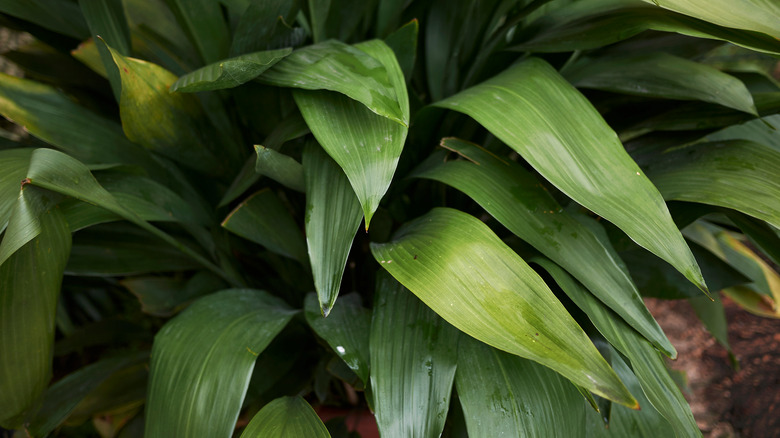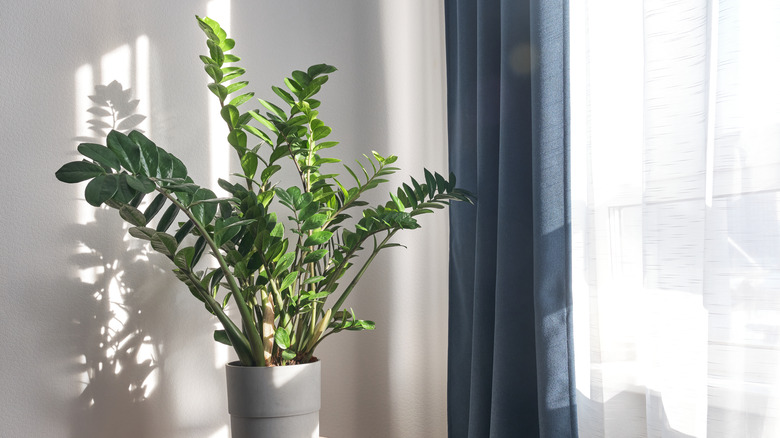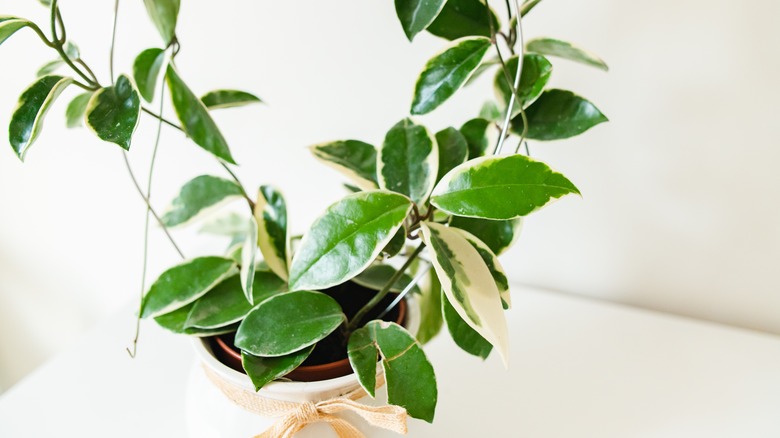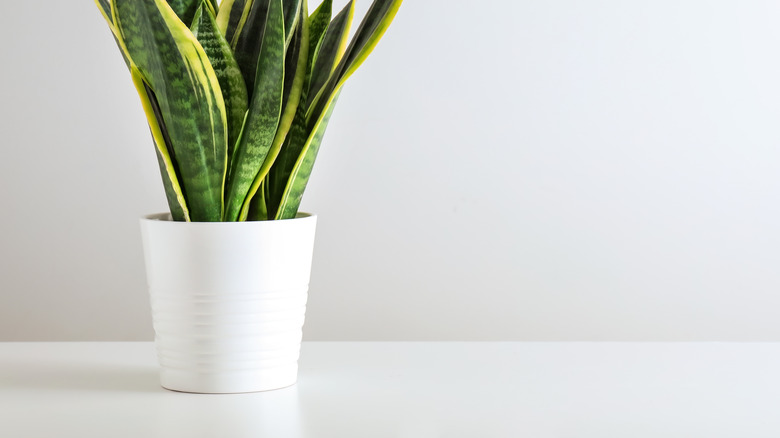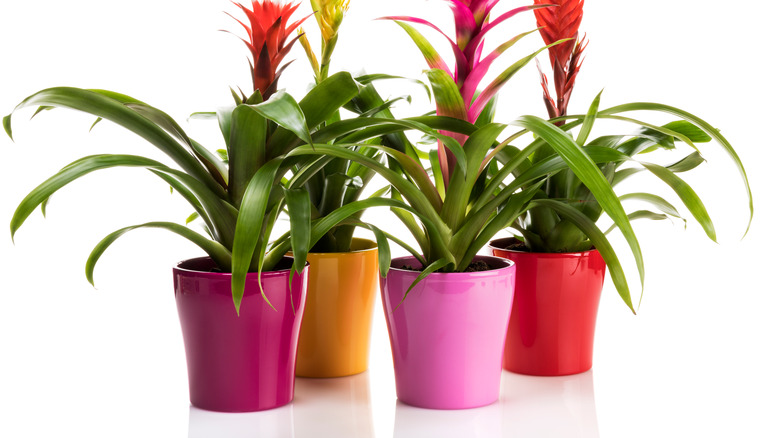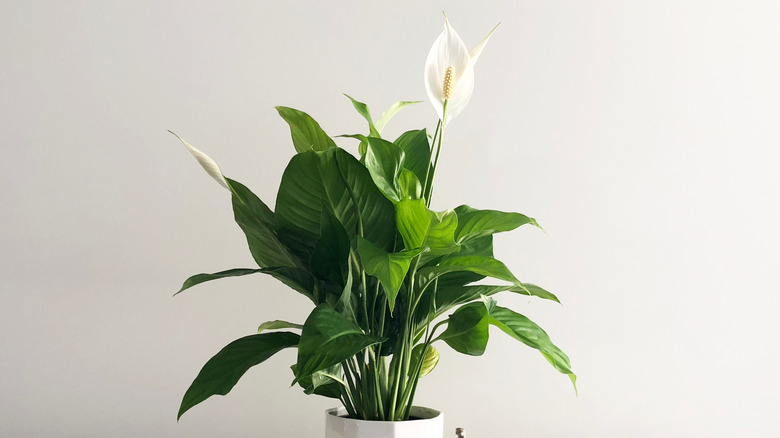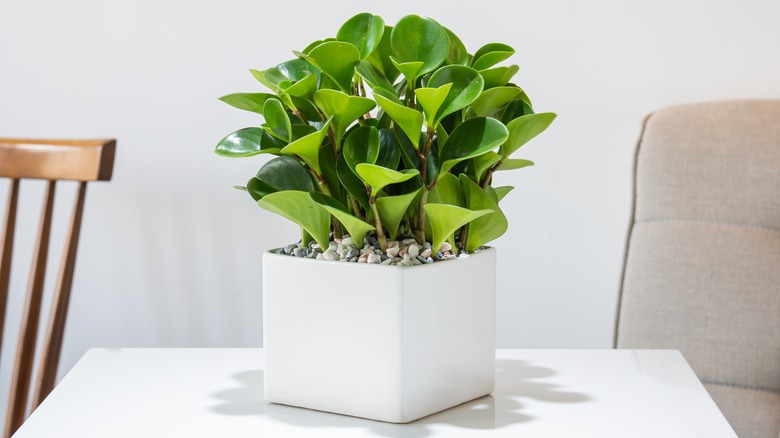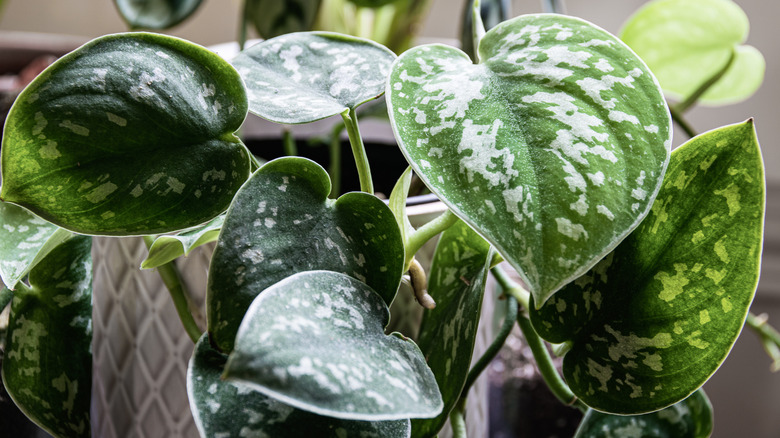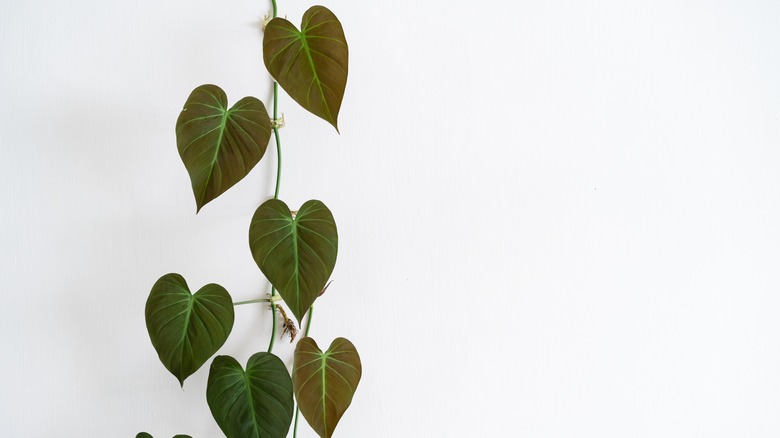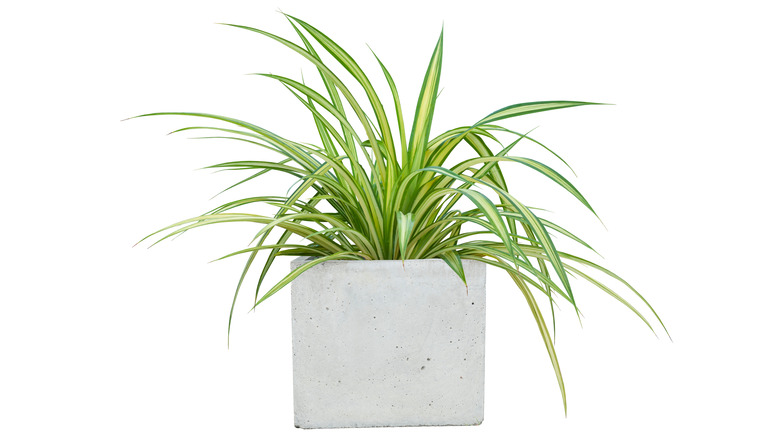10 Easy-To-Care-For Plants For Beginners
Plant parenthood has become a right of passage. Gorgeous Instagram photos and snappy TikTok videos have given new life to a decades-old decor trend, introducing the positive effects of plant ownership to a new generation. According to The Sill, indoor plants have numerous benefits for the mind and body. Houseplants can help bolster mood, improve creativity, and reduce stress or fatigue. In the workplace, their soothing presence is proven to limit sick-leave absences, increase work performance, and boost productivity. Indoor plants also drastically improve the air quality in your home (via Piedmont). In fact, a 1989 NASA study found that houseplants and the microorganisms in their soil remove airborne toxins and chemicals, such as benzene and formaldehyde, from the air.
Although houseplants are as useful for our well-being as they are beautiful to gaze upon, beginners often struggle to care for them. Many opt for breathtaking but fussy plants to start out and are baffled when they die. To avoid such heartbreak, new plant parents should start with easy-to-care-for houseplants, such as the 10 in this list, to ease into plant ownership.
Cast iron plant (Aspidistra elatior)
The cast iron plant is a must-have for the newbie plant collector. It is a visually stunning house plant perfect for brightening up the shadowy corners and dark hallways of your home. It is also difficult to kill. The evergreen plant can reach 2 to 3 feet in height and produces long, arching, dark-green leaves that come to a point. Each leaf can grow up to 2 feet long creating a lovely visual impact wherever it is placed. It is also non-toxic, which is good news for plant owners with curious pets who like to nibble on things they shouldn't. Cast Iron plants were once a staple of every parlor, boarding house, and bank lobby in the Victorian Era (via Amusing Planet). This is largely due to the fact that the plant is, as its name suggests, tougher than iron. It could withstand the low light and poor air quality conditions produced by gas lighting in the late 1880s, thriving in spite of pests, drought, or temperature fluctuations.
Although this plant is practically indestructible (via UAEX), there are some general care tips to keep in mind. According to Houseplant Resource Center, it is important to keep cast iron plants out of direct sunlight to avoid burning the leaves. They require well-draining soil and should be left to dry out completely between watering. If you notice the tips of the leaves are turning yellow or brown, it is likely the plant is becoming waterlogged.
ZZ plant (Zamioculcas zamiifolia)
If you have a notoriously brown thumb, the easy-to-care-for ZZ plant will make an excellent addition to your home. Nicknamed the eternity plant, ZZ plants are slow growers that thrive in low-light environments and require minimal care. This decorative, beginner-friendly house plant has thick, waxy, oval-shaped leaves that grow on graceful upward stems. The leaves have a rich green color and are so shiny that they are often mistaken for artificial plants. There are multiple ZZ varieties with variations in color, including the ZZ "raven," which has leaves that darken to a purplish-black color over time. ZZ plants originated in East Africa. In its native environment, the ZZ plant prefers high-heat and dry soil. According to HGTV, ZZ plants grow from a bulbous rhizome which allows the plant to store water for long periods of time. As a result, the plant doesn't require high-humidity environments and can handle the forgetful whims of its owners.
ZZ plants can be placed anywhere inside the home that receives bright, indirect light. They handle lower-light conditions well, but too little light will cause the plant to grow leggy and thin. On the other hand, too much direct light will cause the leaves to burn. Placing the plant in a room with a window is normally sufficient. This houseplant isn't picky about its soil, although it should be well-draining to avoid root rot. Water only when the soil has completely dried out, which can take anywhere from 10 to 14 days.
Hoya plant (Apocynaceae)
Also known as wax vines or Porcelainflower, hoyas are vining plants known for their glossy, waxy, succulent-like leaves and breathtaking pink and white star-shaped flowers. These showy blooms resemble bursting fireworks and produce a range of sweet scents. Some varieties smell like chocolate, vanilla, and cinnamon, while others have a more traditional perfumy scent. Unfortunately, the showy blooms don't last long; however, their beauty is all the more special for their brevity.
There are dozens of different hoya varieties to choose from, which has prompted many fans to participate in a crazy called "hoya hoarding" (via Planterina). Some are variegated or speckled, like the hoya pubicalyx, while other common varieties, like the hoya krinkle or the hoya obovata, feature uniquely shaped leaves (via Happy Sprout).
Despite the variety, most hoyas require the same low-maintenance care. In general, hoyas love heat and high humidity. They like at least six hours of bright, indirect sunlight, preferably in a north- or east-facing window. The more light they receive, the greater the odds that they will bloom indoors. All hoya types should be planted in loose, nutrient-rich potting soil and kept root bound. During the warmer months, hoyas should be watered more frequently than in the winter months.
Snake plant (Sansevieria trifasciata)
Snake plants are beloved beginner houseplants thanks to their low-maintenance care requirements and general hardiness (via Alamanac). The plant is native to areas of West Africa, including the Congo and Nigeria.
Also known as "mother-in-law's tongue," "viper's bowstring hemp," and "Saint George's sword," the plant produces tall, erect leaves that come to a sword-like point. There are numerous varieties to choose from, many of which are variegated in dark greens, creams, and yellows. They vary in height depending on the variety, although some can grow up to eight feet tall. Snake plants are fast growers, averaging 4 to 12 inches per year (via Bustling Nest). Snake plants are heat-tolerant plants that thrive in dry conditions (via Apartment Therapy). They should be watered infrequently and allowed to dry out completely between waterings. According to Leaf Envy, they may only need to be watered once every two weeks, sometimes less depending on the season and light conditions.
Although snake plants are native to the rocky, dry regions of tropical western Africa, indoors they can grow in a range of light conditions (via Missouri Botanical Garden). They perform best in bright, indirect sunlight, but will live happy lives in areas that receive ample shade as well. This makes them the perfect plant to brighten up basements, hallways, and windowless bathrooms. Like many other houseplants, snake plants are good air filters. According to Healthline, snake plants are ideal bedroom decor because they can convert carbon dioxide into oxygen at night.
Bromeliad (Bromeliaceae)
Bromeliads are colorful tropical plants native to Chile, Argentina, and the Caribbean (via The Sill). According to Bromeliads.info, there are over 2,500 species in the bromeliad family that have been around for millions of years, making them primeval plants. Some bromeliad varieties are terrestrial and some are epiphytes or air plants that grow on other plants without soil. All are flowering plants that produce vibrant colored blooms.
In general, bromeliads are excellent houseplants for beginners because they don't need much attention to thrive. As tropical plants, they like bright spaces without direct sunlight, although some varieties do well in complete shade (via Leafy Journal). Typically, bromeliads do well on shaded patios or in areas of the home that receive gentle, dappled light. Bromeliads can be grown indoors or outdoors but have a preference for warm temperatures and humid environments. Maintaining an indoor humidity level of 60% or higher can be tricky but it isn't impossible. Keeping a bromeliad near a humidifier or using a spray bottle to mist the plant regularly can boost the plant's humidity levels. Placing the plant near other plants is also helpful for increasing the overall humidity level in a room.
Bromeliads are also drought-tolerant plants that despise being over-watered. The leaves of this houseplant come together at the base to form a "tank" that stores larger volumes of water. As a result, they require water once every two to three weeks, depending on the season and the amount of light it receives.
Peace lily (Spathiphyllum)
Peace Lilies are a common houseplant for beginners due to their hardy makeup and forgiving natures (via HGTV). In addition to being a gorgeous addition to interior decor, they are also frequently given as gifts to new homeowners or in funeral arrangements to symbolize a peaceful passing.
The peace lily is a tropical plant native to the Colombian and Venezuelan rainforests. It has lush, arching, and dark-green foliage that can grow up to 4 feet tall indoors (via Plantophiles). Under the right conditions, peace lilies will produce white blooms in the spring and summer. These erect blooms, which are actually modified leaves called bracts, resemble a white flag raised in surrender, giving the plant its name (via Our House Plants). It is easy to tell when a peace lily needs more water. The leaves will droop dramatically and perk back up as soon as their thirst is quenched. Be careful not to overwater, as this houseplant is extremely sensitive to root rot. Watering once a week is normally enough. If they receive too much, the leaves may alternatively turn yellow, and the tips may become crisp and brown.
Peace lilies do well in a range of light conditions as well. Although they will only produce their signature white blooms when given bright, indirect light, the plant will not wither away in lower-light environments. Regular potting soil is normally fine, although they do require a well-draining mix and a pot with an adequate drainage hole.
Peperomia (Peperomia obtusifolia)
Peperomias, also known as baby rubber plants or Pepper face plants, are perennial flowering plants native to Mexico and South America (via Houseplants Expert). There are over 1,000 different species, and it's most commonly referred to as the Peperomia obtusifolia.
Beginners love the ornamental plant for its succulent-like leaves that grow in a bushy form from thin, non-woody stems. The foliage shape and color vary depending on the cultivar. Some are grey, red, or purple, and they often have textured or heart-shaped leaves. However, more common peperomias have round, bright green leaves with stunning yellow or white variegation. Peperomia plants typically bloom in the springtime, producing non-showy flower spikes. Growing peperomias indoors is easy, regardless of your skill level or prior knowledge of plants. They do well in containers and can be planted year-round (via Houseplants Expert). Peperomia plants are slow growers that remain fairly compact as they mature, making them ideal for small spaces. They are also forgiving plants that don't mind being ignored now and again.
In general, peperomias require a chunky, loose potting mix with ample drainage. Orchid potting mix is ideal. They don't require fertilizer or plant food and should be watered only when the soil is dry. Peperomias that are kept in a spot with medium to bright light are able to keep their bright colors more easily (via Missouri Botanical Garden). You will know if the light isn't right if the leaves begin to burn, turn yellow, or fall off the stems.
Silver satin pothos (Scindapsus pictus)
The silver satin pothos is a truly gorgeous vining houseplant that looks lovely in mantles or in a hanging planter. Beginners will love its dense, stunning foliage and appreciate how easy it is to care for.
Despite its name, the silver satin pothos is not a true pothos (via Bloomscape). Although they are remarkably similar in appearance and care, the silver satin pothos has thicker, shinier leaves that have a mixture of grey and silver coloring (via Bean Growing). In the light, these waxy heart-shaped leaves are reflective, causing a delightful shimmer effect not found in the average houseplants. To maintain the lush, metallic sheen of the plant's foliage, the silver satin pothos requires bright, filtered light and moderate humidity. The normal humidity of a house is between 40% to 60%, which is ideal for this low-maintenance houseplant (via Indoor Temp). A well-draining soil mix is needed to support the plant and avoid root rot from overwatering. Similar to the peace lily, a silver satin pothos will tell its owners when it is thirsty. The leaves will begin to curl at the edges, indicating that it needs water. These key indicators help new plant parents establish a consistent watering schedule.
As beautiful as they are, silver satin pothos are considered toxic by the ASPCA. They should be kept out of reach of cats and dogs. Thankfully, the plant's aerial roots allow it to vine upward with the help of a trellis or coco coir pole.
Velvet leaf philodendron (Philodendron hederaceum)
The velvet leaf philodendron, also known as philodendron micans, is one of the most beautiful low-maintenance house plants. They have heart-shaped leaves like pothos and Scindapsus plants, but with a velvety texture that appears in deep greens, purplish-reds, and bronzes (via Bustling Nest). New leaves typically start out in a bright, orange-red color and darken over time.
This beginner house plant is a perennial native to Mexico and certain islands of the Caribbean. Their subtropical and tropical origins make them ideal houseplants because they require lower light conditions and slightly cooler temperatures. To see this plant thrive, it is important to keep it away from drafty windows and vents that can drastically alter its temperature. According to Garden Pals, the plant is happiest when owners can replicate rainforest conditions. However, that doesn't mean you have to turn your home into a wet, humid jungle. Velvet leaf philodendrons will do well in rich, well-draining soil and indirect light. They should be watered when the first few inches of soil are dry. If possible, watering with filtered water will keep the plant in good spirits and allow it to grow at a fast pace.
As you get the hang of caring for the velvet leaf philodendron, you can experiment with propagation. Simply cut above the node where the leaf meets the stem (via Sprouts & Stems). Then, plant the leaf directly in the soil or place it in water until the roots begin to grow.
Spider Plant (Chlorophytum comosum)
According to Wisconsin Horticulture, the spider plant is one of the most common houseplants for beginners. It is a fun plant with plenty of visual impact, but it is also highly tolerant of neglect, grows fast, and is easy to propagate. It is also one of the better plants to have for removing toxic chemicals from indoor air.
This low-maintenance houseplant is sometimes referred to as a ribbon plant or an airplane plant. It has narrow, pointed leaves that cascade outward from a single point like a fountain. They vary in color, although most are green with a central white or yellow stripe down each leaf. Under the right growing conditions, a spider plant will produce wiry stems which grow white, star-shaped blooms. The plant also grows plantlets that resemble spiders hanging from a web. These "spiders" can be removed from the mother plant and potted in the soil to create dozens of spider plants.
Spider plants are native to the coast of South Africa, where they thrive in average household temperatures and moderate humidity. Filtered light is best to avoid burning the fragile leaves as well. Inconsistent watering patterns are no trouble at all for the spider plant thanks to their thick, fleshy roots and rhizomes which can store water. Ideally, they prefer lightly moist soil at all times and should be watered when the first 1 to 2 inches are dry to the touch (via Bob Vila) .
